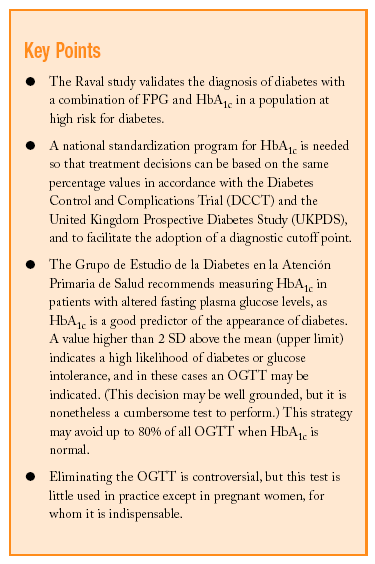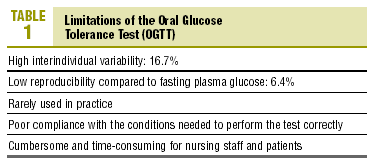The Raval study published in this issue of Atención Primaria reports the first known attempt in Spain to validate the diagnosis of diabetes with glycosylated hemoglobin (HbA1c) values in a population at high risk for diabetes.
Different diagnostic methods exist depending on the intent of the study:
1. Epidemiological studies have classically used the oral glucose tolerance test (OGTT) with a single determination 2 hours after the glucose overload.
2. For population screening in the population at high risk for diabetes, fasting plasma glucose (FPG) is usually recommended as a precise, cheap, reproducible and simple test. Many authors have drawn attention to the need to add HbA1c determinations for diagnostic purposes, or to limit the number of subjects who will need an OGTT because their blood glucose level is below the diagnostic threshold but their HbA1c value is above the upper limit of normality (2 SD). This latter strategy would avoid up to 80% of all unneeded OGTT.1
3. For individual clinical diagnosis, the 1997 American Diabetes Association (ADA) and the 1999 World Health Organization criteria are used. However, these recommendations differ radically with regard to the use of OGTT in persons with impaired fasting glucose (IFG) levels.
The Expert Committee on the Diagnosis and Classification of Diabetes Mellitus of the ADA recently decided2 to reduce the lower limit of normality for FPG from 110 to 100 mg/dL. This decision is aimed at detecting, on the basis of IFG (100 to 125 mg/dL), a number of persons similar to those that would be detected on the basis of impaired glucose tolerance (IGT) who may benefit from lifestyle interventions shown to be effective in delaying the appearance of diabetes. However, this measure is controversial3 because it fails to take into account the cost/benefit ratio of this decision, which will double the prevalence of IFG3 (a consequence which itself merits a separate editorial).
Epidemiological studies in different populations were needed to decide whether a cutoff point for FPG of 126 mg/dL is equivalent to a blood glucose value of 200 mg/dL measured 2 hours after oral glucose overload, although these methods do not detect the same patients or have the same diagnostic capacity since they measure different alterations. Many authors continue to consider the OGTT as the best test, given the lack of a better gold standard. However, the use of this test has been justified more on the basis of historical reasons and common accord than because of its intrinsic qualities.4
The infrequent use of OGTT in clinical practice (fewer than 20% of all patients with diabetes are diagnosed with this method) and the diagnostic limitations of this method (Table) have led the ADA to advise against its use in favor of FPG, considered the test of first choice. There is no consensus on this point, as the WHO and the European Council still recommend OGTT for patients in the same risk category as IFG to distinguish between persons with IFG only and individuals who fulfill the criteria for diabetes or IGT. This does not seem to be a workable solution given the volume of patients who fulfill the criteria for IFG and the need for a second positive test result. Given the variability in OGTT results3 (>15%) and its other drawbacks, it is rarely used.
Fasting plasma glucose increases with age from the third to the sixth decade of life, and remains unchanged thereafter.5 In contrast, plasma glucose 2 hours after a glucose overload is markedly higher in persons older than 65 years.2,4 There is no evidence of increased insulin resistance that would account for the excess sensitivity of OGTT in older persons, a result that leads to significant differences in the prevalence of diabetes found with each of these two methods. In the San Antonio cohort,2 persons with OGTT-diagnosed diabetes were fivefold as likely as FPG-diagnosed patients (125 mg/dL) to recover normal glucose tolerance after 7 to 8 years.
The variability of FPG ranges from 5% to 7%.5 If we consider a biological rate of variation of 6.9% for a true value of FPG of 126 mg/dL, the resulting 95% confidence interval ranges from 109 mg/dL to 143 mg/dL.
In the presence of classical symptoms of diabetes, the diagnosis is usually straightforward, and a single plasma glucose measurement (>200 mg/dL) often suffices. Problems arise, however, in asymptomatic individuals in whom the diagnosis is based exclusively on threshold glucose values that vary from day to day. This justifies the need to confirm the results with a second test. The excessive variability of the OGTT justifies the proposal of the ADA expert committee to eliminate this test in favor of FPG. This committee has come out against the proposal to include HbA1c as a new diagnostic method despite its good correlation with the appearance of micro- and macrovascular complications, because its correlation with FPG was not considered sufficiently solid and because of the lack of standardization to ensure that the results are comparable. The committee probably also considered the discrepancies that would arise because of the identification of three different subpopulations depending on the criteria used, a factor that might further confuse the issue.
As an alternative to OGTT, HbA1c could be used instead as a much more reproducible test with a rate of variation lower than 3% (2% in the Raval study). Hemoglobin A1c measurement identifies hyperglycemia present over a period of 12 weeks (as opposed to casual test results indicating hyperglycemia), and when combined with FBG it increases the sensitivity and specificity of the latter.
The limitations of this strategy are mainly its low availability, the lack of a universal standard (95% in the USA; accepted as a diagnostic method in Japan, where the standardization process has been completed; standardization efforts under way in Europe). In the Raval study the normal value was taken as 0.5 points below the reference range of the Diabetes Control and Complications Trial (DCCT), which might explain why the cut point was more than 3 SD above the mean value, when most authors recommend a cut point of 2 SD above the mean.
Another limitation that has been identified but does not appear to affect the conclusions of the study is the fact that HbA1c values are modified by any circumstance that affects the half-life of red blood cells (such as hemoglobin-related disorders, hemolytic anemia or transfusions). This problem is minimized, apparently, with the use of high-pressure liquid chromatography (HPLC).5
Are the results of the Raval study applicable to other populations? The present study was done in a population with characteristics that distinguish it from the average situation: older mean age (greater sensitivity of OGTT), 20% immigrants (different ethnic groups) high BMI, and a high (73%) prevalence of diabetes in the population at risk. These factors limit the generalizability of the results. Although sensitivity and specificity did not vary with prevalence, predictive values did, in some cases falling to very low levels. Because of the lack of a standardized procedure for measuring HbA1c, the results can only be extrapolated for now to similar populations and studies that use a HPLC technique similar to that used by Jimeno Mollet and colleagues. A national standardization program for HbA1c is needed so that our treatment decisions can be based on the same percentage values in accordance with the DCCT and the United Kingdom Prospective Diabetes Study (UKPDS), and to facilitate the adoption of a diagnostic cutoff value.
The Diabetes in Primary Health care Study Group (Grupo de Estudio de la Diabetes en la Atención Primaria de Salud, GEDAPS) recommends measuring HbA1c in patients with IFG, as HbA1c is a good predictor of the appearance of diabetes. A value higher than 2 SD above the mean (upper limit) indicates a high likelihood of diabetes or glucose intolerance, and in these cases an OGTT may be indicated. (This decision may be well grounded, but it is nonetheless a cumbersome test to perform.) This strategy may avoid up to 80% of all OGTT when HbA1c is normal.
In any case, within the range of values considered to indicate IFG, a multifactorial approach that considers all cardiovascular risk factors is more efficient and achieves greater reductions in cardiovascular risk than an approach centered exclusively on circulating glucose levels. The clinical identification of the metabolic syndrome, which may course with IFG, IGT or diabetes and influence all risk factors,6 may be more useful than wasting time distinguishing between glucose regulation disorders that will have little influence on our treatment decisions.











